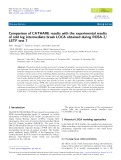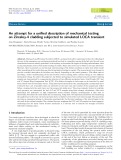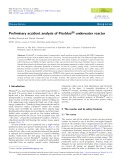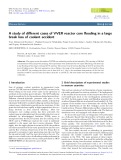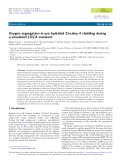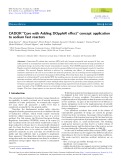
Loss of Coolant Accident
-
The paper presents the modeling of the Test Facility ROSA-2/LSTF in the calculation code CATHARE 2.V2.5. OECD/NEA ROSA-2 Project Test 7 was conducted with the Large Scale Test Facility on June 14, 2012. The experiment simulated the thermal-hydraulic responses during a PWR 13% cold leg Intermediate Break Loss Of Coolant Accident (IBLOCA).
 8p
8p  christabelhuynh
christabelhuynh
 30-05-2020
30-05-2020
 20
20
 1
1
 Download
Download
-
The present study is an attempt to provide a unified description of the failure not directly depending on the tested geometry. This effort aims at providing a better understanding of the link between several existing safety criteria relying on very different mechanical testing.
 9p
9p  christabelhuynh
christabelhuynh
 30-05-2020
30-05-2020
 12
12
 1
1
 Download
Download
-
This paper will provide an update on results from the feasibility study and discuss the attributes of the coated Mo cladding design to meet the challenging requirements for improving fuel tolerance to severe loss of coolant accidents.
 6p
6p  christabelhuynh
christabelhuynh
 30-05-2020
30-05-2020
 19
19
 3
3
 Download
Download
-
The results of simulated transients for three typical PWR accidents are presented: a turbine trip with station blackout, a large break loss of coolant accident and a small break loss of coolant accident. The analyses show that the safety criteria are respected and that the reactor quickly reaches a safe shutdown state without operator action and external power.
 10p
10p  christabelhuynh
christabelhuynh
 31-05-2020
31-05-2020
 39
39
 1
1
 Download
Download
-
The paper covers the results of VVER core reflooding studies in fuel assembly (FA) mockup of 126 fuel rod simulators with axial power peaking. The experiments were performed for two types of flooding. The first type is top flooding of the empty (steamed) FA mockup.
 11p
11p  christabelhuynh
christabelhuynh
 30-05-2020
30-05-2020
 40
40
 2
2
 Download
Download
-
This work aims at determining the key parameters controlling the average oxygen profile within the sample in the two-phase regions at 1200 °C. High temperature steam oxidation tests interrupted by water quench were performed using pre-hydrided Zircaloy-4 samples.
 8p
8p  christabelhuynh
christabelhuynh
 30-05-2020
30-05-2020
 13
13
 1
1
 Download
Download
-
This study shows that, by applying this CADOR approach to a Generation-IV oxide-fuelled SFR, the resulting core can be made inherently resistant to reactivity insertion accidents, while also having increased resistance to loss-of-coolant accidents.
 13p
13p  christabelhuynh
christabelhuynh
 29-05-2020
29-05-2020
 7
7
 0
0
 Download
Download








